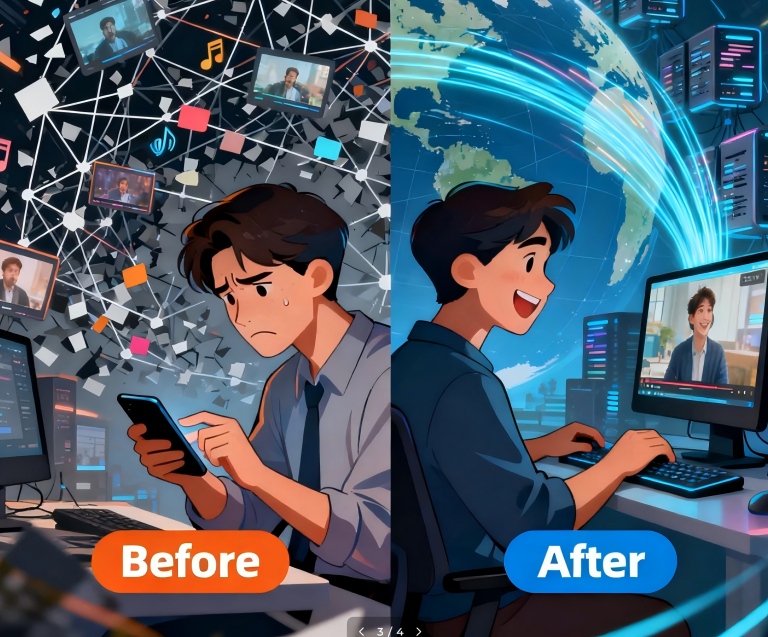
Have you ever settled in to watch your favorite show online, only to have the video stutter and freeze every few seconds? Or maybe you were listening to a podcast, and the audio kept cutting out, forcing you to rewind and lose your place. It's a frustrating, confusing experience, isn't it? We live in an age where high-speed internet is the norm, yet we still face the sudden, jarring reality of buffering. You might find yourself asking, "Why is this happening to me? Is my Wi-Fi bad? Is the streaming service just unreliable?" It's a natural question, but the real answer lies in a problem far bigger than your home network.
The media and entertainment industry is like a massive pipeline. Your favorite streaming service is at one end, and you, the viewer, are at the other. When you press play, a colossal amount of data—the video and audio files—has to travel from the service's data center, through a maze of internet cables and routers, all the way to your device. If that data has to travel thousands of miles and the pipeline isn't big enough, you get a digital traffic jam. The result? That infuriating little loading circle, buffering that kills the moment, and a user experience that feels cheap and unreliable. This isn't just a technical issue; it's a direct hit to the viewer's immersion and loyalty.
So, how do you solve a problem that is fundamentally about distance and scale? How do you ensure a crystal-clear, uninterrupted experience for a user in a remote village when your content servers are on another continent? The answer is a Content Delivery Network (CDN), but not the simple version you might think of. This isn’t just about caching images for a website; it’s about a powerful, intelligent network that transforms the very way we consume media. It's the difference between a single, clogged pipeline and a global network of hyper-efficient delivery trucks, ready to bring high-quality content directly to your doorstep.
The Unseen Problem: Why Streaming Is So Hard
The real challenge with media and streaming is the sheer volume and nature of the data. Unlike a simple web page, video and audio content are massive. A single 4K video can be gigabytes in size. To make matters worse, it's not a single download. It’s a continuous stream of data that must be delivered consistently and without interruption to provide a seamless playback experience. This is where things get complicated.
The Latency Trap: Just like with any website, latency is the enemy. The physical distance between the viewer and the origin server creates a delay. For a website, a few hundred milliseconds might be tolerable, but for a live stream or a video on demand, every single millisecond counts. That tiny delay is what causes the dreaded buffering. It’s a physical problem that no amount of server upgrades can truly fix.
The Traffic Spike Problem: Media consumption isn't uniform. A live sports event, a new episode of a hit show, or a popular musician's album release can create a sudden, massive surge in demand. Your single origin server, no matter how powerful, cannot handle millions of simultaneous requests. It would be like trying to serve every person at a stadium from one small concession stand. The server gets overwhelmed, the performance drops, and the user's experience is ruined.
The Quality Challenge: Users expect high-quality video and audio. But delivering a 4K stream requires a massive amount of bandwidth. If the network path is congested or inefficient, the streaming service has to lower the quality of the content to prevent buffering. This is why your video suddenly looks fuzzy or pixelated. The service is trying to survive the journey, but it sacrifices quality to do so.
The CDN Solution: From Buffering to Brilliance
A CDN for media and streaming is a highly specialized piece of technology that directly tackles these issues. It's a profound leap from simple content delivery to a complex, intelligent system designed for the unique demands of video and audio.
Distributed Edge Caching for Video on Demand (VOD): For services like Netflix or YouTube, a CDN caches popular video segments on its edge servers around the world. When you press play, your device requests the video from the closest CDN server, not the distant origin server. This drastically reduces the distance the data has to travel, eliminating latency and making the video start almost instantly. It's the digital equivalent of having your entire library of shows and movies available at a local corner store.
Live Streaming Acceleration: Live events are even more challenging because the content isn’t pre-recorded. A CDN for live streaming is designed to handle this dynamic flow of data. It ingests the live feed from your origin server and then distributes it simultaneously to all of its global edge servers. When a viewer connects, they are served the live feed from their nearest edge server, ensuring minimal latency and no buffering. It's what allows millions of people around the world to watch the same event at the same time without the picture freezing.
Intelligent Quality Control: A modern media CDN doesn't just deliver content; it delivers it with intelligence. It uses algorithms to analyze a viewer’s connection in real time and deliver the right quality video without buffering. This is called Adaptive Bitrate Streaming (ABS). The CDN delivers a series of small, different-quality video chunks. If a user's connection slows down, the CDN automatically switches to a lower-quality chunk to keep the video playing smoothly. When the connection improves, it switches back to a higher quality. It's a delicate dance that happens invisibly in the background, ensuring a consistent, high-quality experience without any manual intervention.
Security at the Edge: Media platforms are constant targets for piracy and DDoS attacks. A CDN provides a critical layer of defense. It can secure your content with features like token authentication, which ensures that only authorized users can access your streams. And, as a distributed network, it can absorb a massive DDoS attack, acting as a shield for your origin server. It's a proactive security measure that protects your most valuable asset: your content.
In the end, the power of a CDN for media and streaming is that it makes the technology disappear. It takes the frustrating reality of latency and turns it into a seamless, high-quality experience. It transforms a single, bottlenecked connection into a global, distributed network that serves your audience with speed, reliability, and security. For any business that relies on delivering video or audio, the question isn't whether you need a CDN; it's whether you're using one that's powerful enough to meet your users' expectations.

